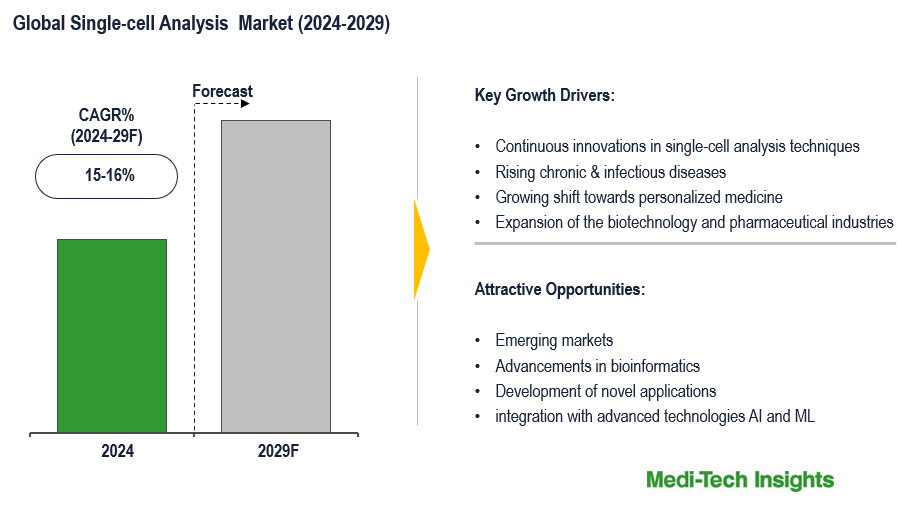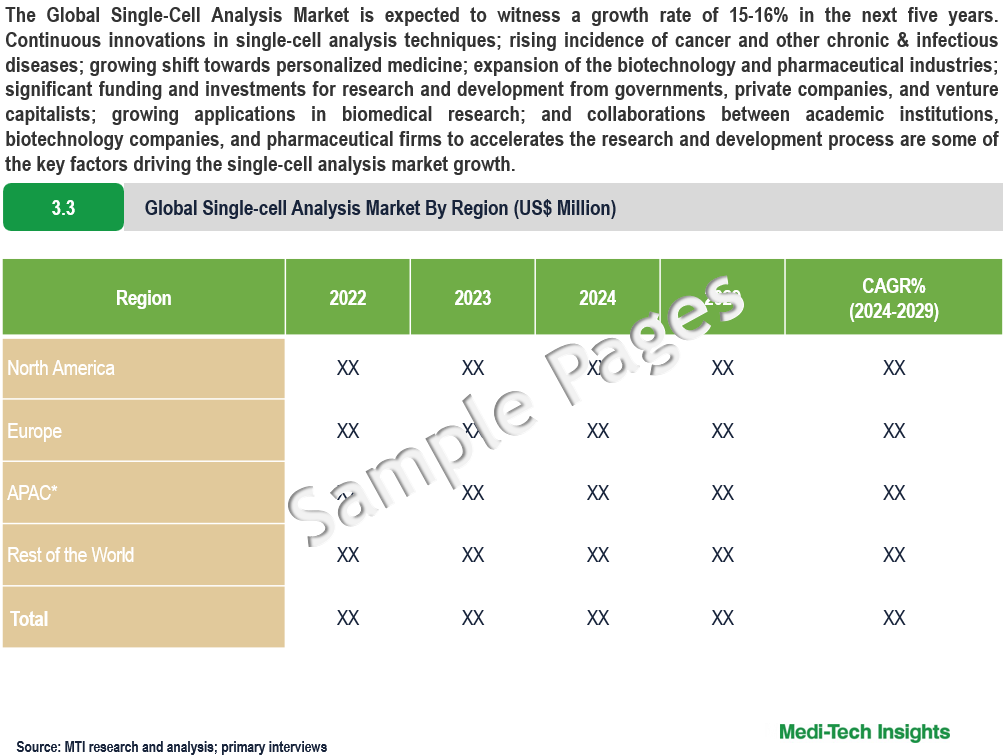
Global Single-Cell Analysis Market Size, Industry Growth, Share, Trends, Demand & Growth Analysis and Forecast 2024 to 2029

The Global Single-Cell Analysis Market is expected to witness a growth rate of 15-16% in the next five years. Continuous innovations in single-cell analysis techniques; rising incidence of cancer and other chronic & infectious diseases; growing shift towards personalized medicine; expansion of the biotechnology and pharmaceutical industries; significant funding and investments for research and development from governments, private companies, and venture capitalists; growing applications in biomedical research; and collaborations between academic institutions, biotechnology companies, and pharmaceutical firms to accelerates the research and development process are some of the key factors driving the single-cell analysis market growth. However, high cost of single-cell analysis instruments and reagents; complexity of data interpretation; ethical issues related to the use of human cells in research; and complex regulatory landscape for clinical applications of single-cell analysis is likely to hinder the market’s growth. To learn more about the research report, download a sample report.
Single-cell analysis is the study of individual cells, revealing their genomic, transcriptomic, proteomic, and metabolomic profiles, as well as cell-cell interactions. It enables the analysis of cell-to-cell variation, the isolation and molecular profiling of individual cells, and has applications in diverse fields like cancer, development, and immunology. Rapid advancements in technologies like fluorescence-activated cell sorting (FACS) and high-throughput partitioning have enabled the profiling of millions of cells, providing unprecedented insights into cellular heterogeneity and function.
Continuous innovations in single-cell analysis techniques to Drive Market Growth
Continuous innovations in single-cell analysis techniques, such as next-generation sequencing (NGS), microfluidics, and mass cytometry, drive market growth by enabling more precise and comprehensive cellular insights. These advanced techniques allow researchers to analyse individual cells with unprecedented resolution, uncovering cellular heterogeneity and rare cell populations that traditional methods cannot detect. Enhanced sensitivity and throughput improve diagnostic accuracy, facilitating the development of personalized medicine. Moreover, innovations reduce costs and complexity, making these techniques more accessible to a broader range of researchers and institutions. As new applications emerge in fields like oncology, immunology, and stem cell research, demand for single-cell analysis grows. This continuous technological advancement not only accelerates scientific discovery but also attracts significant investment and collaboration across academia, biotech, and pharmaceutical industries, further propelling market expansion.
“Single-cell analysis is undeniably a burgeoning field of research. By capturing heterogeneity data, it provides deeper insights into cellular responses and characteristics compared to traditional bulk assays. Miniaturized devices, particularly microwell chips, hold immense potential, enabling the acquisition of data from large sets of individual cells and leading to statistically significant conclusions"- Executive Director, A Global Leading Advanced Research and Bioanalytics Company, United States
Rising Incidence of Cancer and Other Chronic & Infectious Diseases to Fuel Market Growth
The rising incidence of cancer and other chronic and infectious diseases drives market growth for single-cell analysis by increasing the demand for precise diagnostic and therapeutic tools. Single-cell analysis enables the detailed examination of cellular heterogeneity within tumors, aiding in the identification of rare cancer cell subpopulations that may be resistant to treatment. This precision enhances the development of targeted therapies and personalized medicine, improving patient outcomes. Similarly, single-cell analysis provides critical insights into the complex interactions between pathogens and host cells in infectious diseases, informing the creation of more effective treatments and vaccines. The need for advanced research and personalized approaches to manage and treat these diseases fuels investment and innovation in single-cell analysis technologies. As a result, pharmaceutical and biotechnology companies, along with academic institutions, increasingly adopt these cutting-edge tools, propelling the market's expansion.
“Bulk sequencing can explain the most common mutations in a patient’s tumor, but single-cell DNA multi-omics offer insights on which mutations occur at single-cell level. Drug developers are increasingly using single-cell analysis to prioritize targets and pathways for new therapies, demonstrate therapeutic efficacy, and understand resistance mechanisms" - Global Research Head, Leading Pharmaceutical Company, Switzerland
To learn more about this report, download the PDF brochure
Technological Innovations are Driving the Single-Cell Analysis Market
The Single-Cell Analysis market is technology-driven and is marked by constant product innovations. For instance,
- In February 2024, 10x Genomics, Inc. launched GEM-X, a next-generation single cell technology featuring advanced microfluidic chip design and optimized reagents, promising enhanced sensitivity, scalability, cost-effectiveness, data quality, sample recovery, and assay robustness, setting a new standard in single cell analysis
- In June 2023, Singleron Biotechnologies GmbH, launched two new instruments, NEO and Python Junior, to further standardize and automate the single-cell analysis workflow for both research and clinical settings
- In June 2023, Revvity, in collaboration with Honeycomb Biotechnologies, launched the HIVE CLX Single-Cell RNAseq Solution, BeeNetPLUS analysis workflow, and a new HIVE CLX Service offering for US researchers, expanding the accessibility and capabilities of single-cell biology studies
- In May 2023, Deepcell launched the REM-I Platform, integrating AI-powered single-cell morphology analysis and sorting capabilities to drive breakthroughs in cancer biology, developmental biology, stem cell research, gene therapy, and functional screening
US Expected to be a Major Growth Engine in Single-Cell Analysis Market
US is poised to be a major growth engine in the single-cell analysis market. US hosts a robust ecosystem of biotechnology and pharmaceutical companies, along with leading academic and research institutions that are at the forefront of biomedical research. These entities drive demand for advanced single-cell analysis technologies to enhance drug discovery, precision medicine, and understanding of complex diseases like cancer and neurodegenerative disorders. Additionally, the US government allocates substantial funding to support research and development in life sciences and biotechnology, fostering innovation in single-cell analysis techniques and applications. This financial support accelerates the adoption of cutting-edge technologies across research labs and clinical settings. Moreover, the presence of a large and diverse patient population in the US creates opportunities for studying disease heterogeneity and personalized medicine approaches using single-cell analysis. This aligns with the increasing focus on healthcare solutions tailored to individual genetic and cellular profiles. Overall, the combination of research prowess, industry innovation, government support, and healthcare needs positions the United States as a pivotal player driving growth in the global single-cell analysis market.
The Asia-Pacific single-cell analysis market led by China is growing faster compared to other regions. This is attributed to growing biomedical research, Chinese government’s efforts to promote homegrown drug discovery, and growing VC funding for biotech industry. In China, the number of funding rounds grew four times faster than in Europe and the US in 2020, which underscores the growth potential of the Chinese market.
Product Type Segment Analysis
The single-cell analysis market comprises two main product types: Consumables and Instruments. The consumables segment which includes beads, microplates, reagents, assay kits, immunoassays, cell-based assays, and other consumables; is likely to dominate the market as they maintain a steady demand as foundational tools in single-cell analysis workflow. Consumables like reagents and assay kits typically emerge as important segments. Reagents are essential for sample preparation, cell isolation, and analysis, while assay kits provide standardized tools for specific analytical tasks, such as gene expression profiling or protein analysis at the single-cell level. As single-cell analysis techniques become more standardized and integrated into routine laboratory workflows, there is increasing demand for specialized assay kits that simplify and enhance the accuracy of single-cell experiments. This demand is driven by the need for high-throughput solutions and reproducibility in data generation across various research and clinical applications.
On the other hand, instruments segment which includes flow cytometers, NGS Systems, PCR instruments, spectrophotometers, cell counters, microscopes, HCS systems, microarrays, and other instruments is driven by due to their critical role in advancing genomic research and personalized medicine applications. For instance, NGS offers high-throughput capabilities for genomic and transcriptomic analysis at the single-cell level, driving its adoption in research and clinical settings. This segment's growth is fueled by advancements in sequencing technology, expanding applications in understanding cellular heterogeneity and disease mechanisms, and the increasing demand for comprehensive genetic insights.
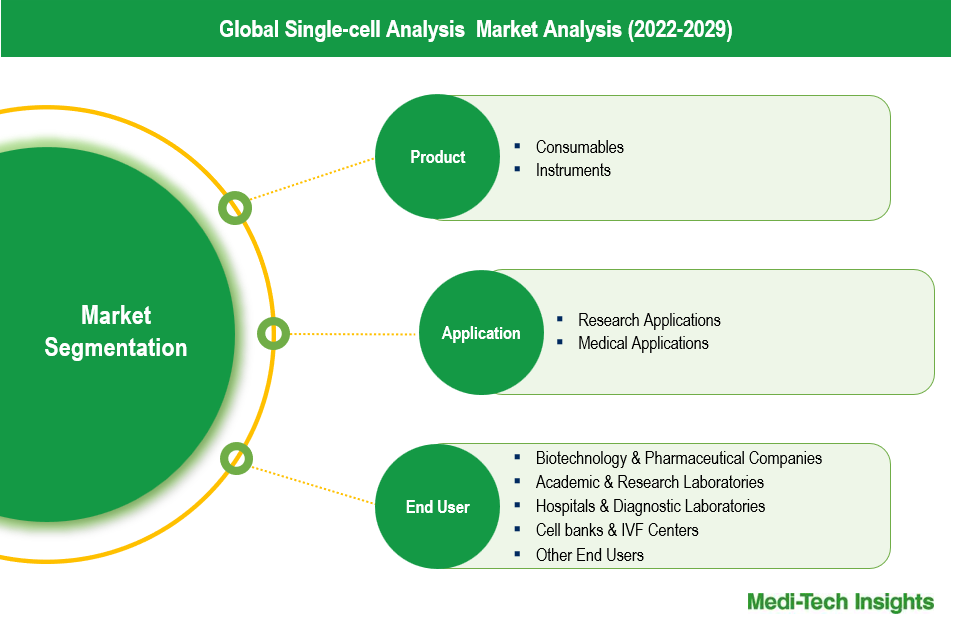
To learn more about this report, download the PDF brochure
Application Type Segment Analysis
The single-cell analysis market can be analyzed based on application types, such as Research Applications and Medical Applications. The research applications segment which includes cancer research, immunology research, neurology research, stem cell research, and other research applications, is expected to is expected to have a higher growth rate. This is primarily driven by advancements in single-cell technologies that have expanded the capabilities of researchers to study cellular heterogeneity, identify rare cell types, and understand complex biological processes at a single-cell level, particularly in areas like cancer research, immunology, neurology, and stem cell research. Additionally, the increasing importance of precision medicine and the need to profile individual cells to identify biomarkers and drug targets is fueling the growth of single-cell analysis in research applications. Furthermore, government initiatives and funding support for biomedical research, globally, are further boosting the demand for single-cell analysis tools in the research segment. The growth in the medical applications segment is driven by driven by the increasing emphasis on personalized medicine and the need to profile individual cells to identify biomarkers and drug targets for applications like noninvasive prenatal diagnosis, in vitro fertilization, and circulating tumor cell detection
Organic and Inorganic Growth Strategies Adopted by Players to Establish Their Foothold in the Market
Players operating in this market are adopting both organic and inorganic growth strategies such as collaborations, acquisitions, and new product launches to garner market share. For instance,
- In June 2024, Singleron Biotechnologies entered into a partnership with the Human Cell Atlas (HCA), to promote global adoption of single cell sequencing, offering discounted access to its analysis platform for HCA collaborating members
- In January 2024, Parse Biosciences a leading provider of accessible and scalable single cell sequencing solutions, acquired data analysis software company, Biomage, integrating powerful data analysis tools into its single cell sequencing solutions to enhance researcher capabilities with intuitive interfaces and faster analysis times
- In October 2023, A4CELL secured a USD 3.2 million (Eur 3 million) investment from BeAble Capital, INNVIERTE ECONOMIA SOSTENIBLE COINVERSION SA SCR, and Dreavent's BIOHORIZONT, aiming to pioneer advancements in living single cell analysis, bolstering technology capabilities and US market presence to tackle complex diseases like cancer
- In August 2023, Cell Microsystems, a provider of pioneering solutions for cell biology research, acquired Fluxion Biosciences, a leader in automated patch clamp technology and cell-based assay tools. This acquisition complements the company’s platforms and applications based on the CellRaft technology, enhancing its offerings for researchers and life science professionals worldwide
The single-cell analysis market is expected to gain further momentum in the coming years due to technological advancements, rising R&D investments, new product launches, and aggressive organic and inorganic growth strategies followed by the players.
Competitive Landscape Analysis: Single-Cell Analysis Market
The global single-cell analysis market is marked by the presence of established market players such as Becton, Dickinson and Company, Danaher Corporation, Thermo Fisher Scientific, Inc., Merck KGaA, Qiagen, 10x Genomics, Inc., Standard BioTools Inc., Promega Corporation, Illumina, Inc., Bio-Rad Laboratories, Inc., Agilent Technologies, Inc., Tecan Group Ltd., Sartorius AG, Takara Bio Inc., and Biomérieux, among others.
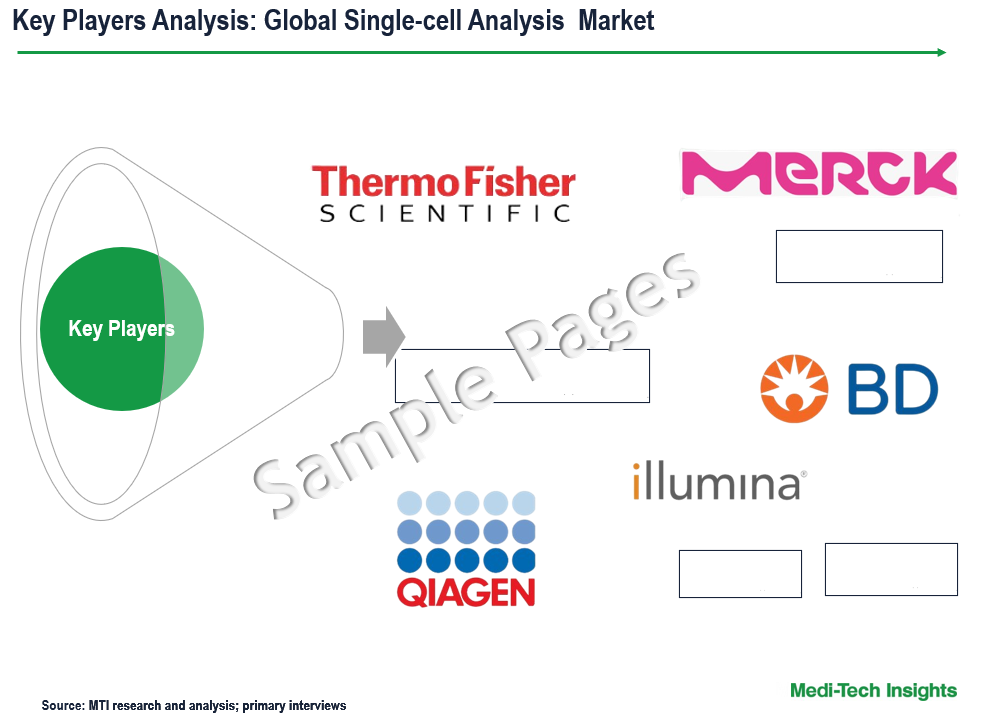
Get a sample report for competitive landscape analysis
Future Outlook of the Single-Cell Analysis Market
The global Single-Cell Analysis market is expected to gain further momentum in the coming years due to the growing need for deeper insights into cellular heterogeneity in various fields, expanding applications in diagnosing and treating diseases, and applications in stem cell research and therapy development. These factors collectively contribute to the growth and evolution of the Single-Cell Analysis market, shaping the landscape of genetic engineering and biotechnology.
Single-Cell Analysis Market Scope
| Report Scope | Details |
| Base Year Considered | 2023 |
| Historical Data | 2022 - 2023 |
| Forecast Period | 2024 - 2029 |
| CAGR (2024-2029) | 15-16% |
| Segment Scope | Product, Application, End User |
| Regional Scope |
|
| Key Companies Mapped | Becton, Dickinson and Company, Danaher Corporation, Thermo Fisher Scientific, Inc., Merck KGaA, Qiagen, 10x Genomics, Inc., Standard BioTools Inc., Promega Corporation, Illumina, Inc., Bio-Rad Laboratories, Inc., Agilent Technologies, Inc., Tecan Group Ltd., Sartorius AG, Takara Bio Inc., and Biomérieux, among others |
| Report Highlights | Market Size & Forecast, Growth Drivers & Restraints, Trends, Competitive Analysis |
Key Strategic Questions Addressed
-
What is the market size & forecast for the Global Single-cell Analysis Market?
-
What are the historical, present, and forecasted market shares and growth rates of various segments and sub-segments of the Global Single-cell Analysis Market?
-
How has COVID-19 impacted the Global Single-cell Analysis Market?
-
What are the major growth drivers, restraints/challenges impacting the market?
-
What are the opportunities prevailing in the market?
-
What is the investment landscape?
-
Which region has the highest share in the global market? Which region is expected to witness the highest growth rate in the next 5 years?
-
Who are the major players operating in the market? What is the competitive positioning of key players?
-
Who are the new players entering the market?
-
What are the key strategies adopted by players?
- Research Methodology
- Secondary Research
- Primary Research
- Market Estimation
- Market Forecasting
- Executive Summary
- Market Overview
-
- Market Dynamics
- Drivers
- Restraints
- Key Market Trends
- Industry Speaks
- Market Dynamics
- Key Revenue Pockets
- Global CRISPR Technology Market - Size & Forecast (2021-2028), By Product Type
- Consumables
- Beads
- Microplates
- Reagents
- Assay kits
- Immunoassays
- Cell-based assays
- Other Consumables
- Instruments
- Flow Cytometers
- NGS Systems
- PCR Instruments
- Spectrophotometers
- Cell Counters
- Microscopes
- HCS Systems
- Microarrays
- Other Instruments
- Consumables
- Global CRISPR Technology Market - Size & Forecast (2021-2028), By Cell Type
- Human Cell
- Animal Cell
- Microbial Cell
- Global CRISPR Technology Market - Size & Forecast (2021-2028), By Technique Type
- Flow Cytometry
- Next-generation Sequencing
- Polymerase Chain Reaction
- Microscopy
- Mass Spectrometry
- Other Techniques
- Global CRISPR Technology Market - Size & Forecast (2021-2028), By Application Type
- Research Applications
- Cancer Research
- Immunology Research
- Neurology Research
- Stem Cell Research
- Other Research Applications
- Medical Applications
- Noninvasive Prenatal Diagnosis
- In Vitro Fertilization
- Circulating Tumor Cell Detection
- Other Medical Applications
- Research Applications
- Global CRISPR Technology Market - Size & Forecast (2021-2028), By End User Type
- Biotechnology & Pharmaceutical Companies
- Academic & Research Laboratories
- Hospitals & Diagnostic Laboratories
- Cell banks & IVF Centers
- Other End Users
- Global CRISPR Technology Market - Size & Forecast (2021-2028), By Region
- North America (U.S. & Canada)
- Europe (UK, Germany, France, Italy, Spain, Rest of Europe)
- Asia Pacific (China, India, Japan, Rest of Asia Pacific)
- Rest of the World (Latin America, Middle East & Africa)
- Competitive Landscape
- Key Players and their Competitive Positioning
- Competitive Positioning of Key Players (2022)
- Offerings Assessment, By Player
- Key Strategies Assessment, By Player (2021-2023)
- New Product & Service Launches
- Partnerships, Agreements, & Collaborations
- Mergers & Acquisitions
- Geographic Expansion
- Key Players and their Competitive Positioning
- Key Companies Scanned (Indicative List)
- Becton, Dickinson and Company
- Danaher Corporation
- Thermo Fisher Scientific, Inc.
- Merck KGaA
- Qiagen
- 10x Genomics, Inc.
- Standard BioTools Inc.
- Promega Corporation
- Illumina, Inc.
- Bio-Rad Laboratories, Inc.
- Agilent Technologies, Inc.
- Tecan Group Ltd.
- Sartorius AG
- Takara Bio Inc.
- Biomérieu
- Other Prominent Players
The study has been compiled based on extensive primary and secondary research.
Secondary Research (Indicative List)
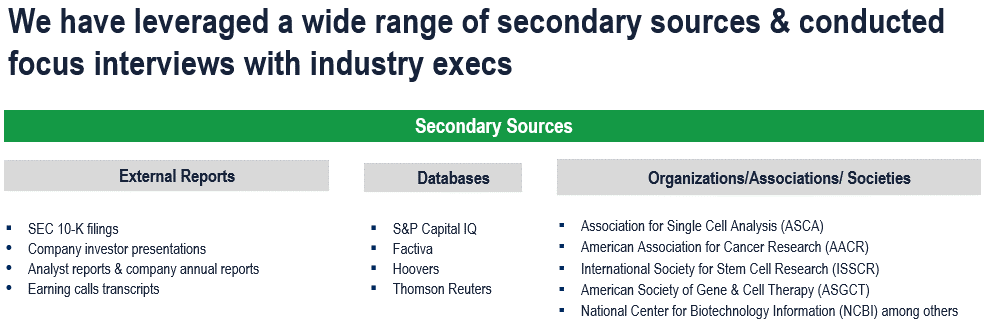
Primary Research
To validate research findings (market size & forecasts, market segmentation, market dynamics, competitive landscape, key industry trends, etc.), extensive primary interviews were conducted with both supply and demand-side stakeholders.
Supply Side Stakeholders:
- Senior Management Level: CEOs, Presidents, Vice-Presidents, Directors, Chief Technology Officers, Chief Commercial Officers
- Mid-Management Level: Product Managers, Sales Managers, Brand Managers, Business Development Managers, Consultants
Demand Side Stakeholders:
- Stakeholders in Biotechnology & Pharmaceutical Companies, Academic & Research Laboratories, Hospitals & Diagnostic Laboratories, Cell banks & IVF Centers and Other End Users
Breakdown of Primary Interviews
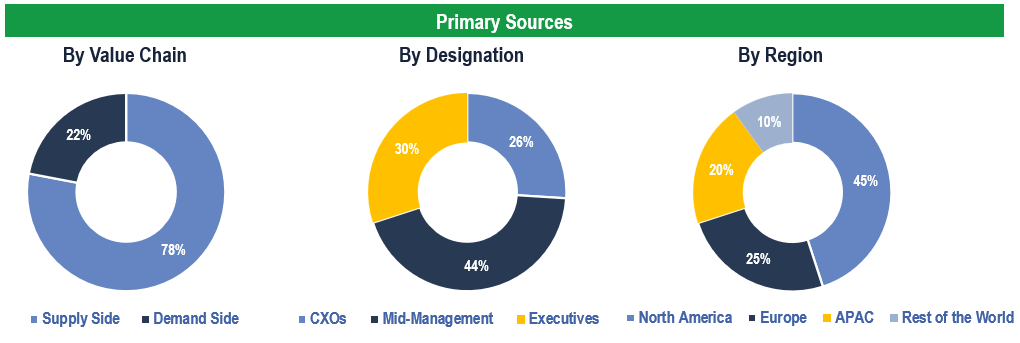
Market Size Estimation
Both ‘Top-Down and Bottom-Up Approaches’ were used to derive market size estimates and forecasts.
Data Triangulation
Research findings derived through secondary sources & internal analysis were validated with Primary Interviews, Internal Knowledge Repository, and Company Sales Data.

